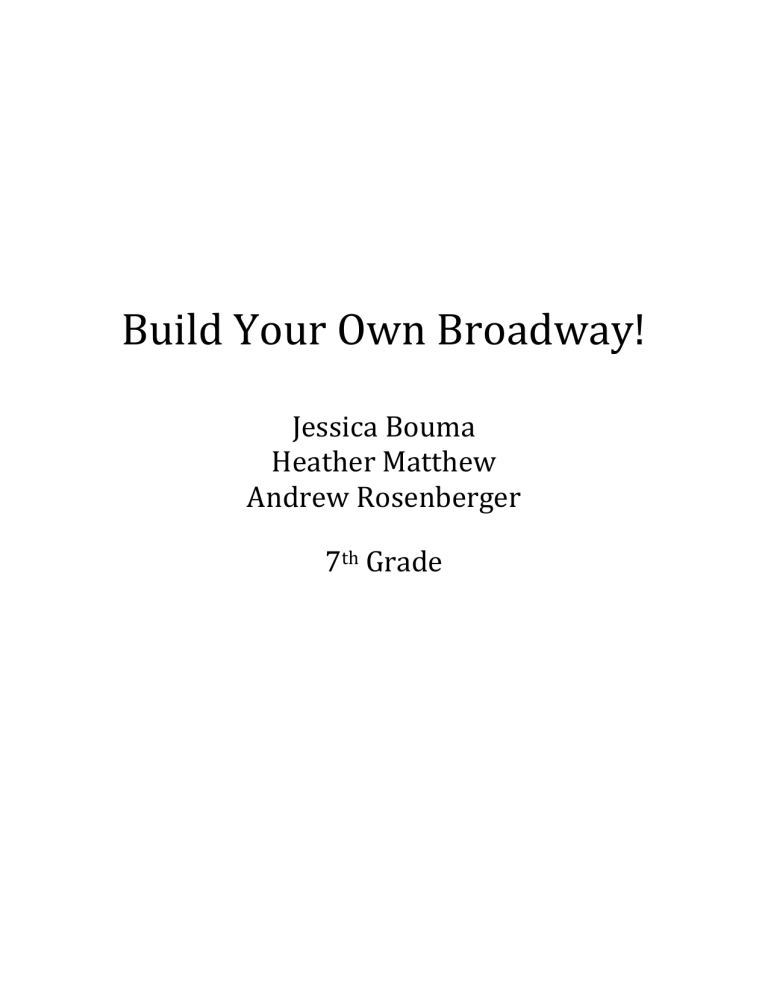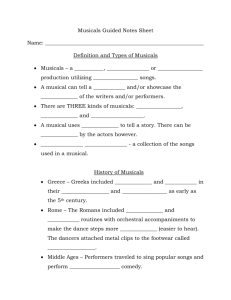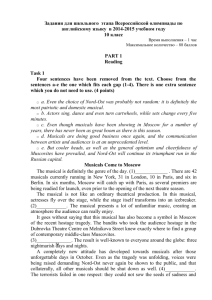File - Jessica Bouma's Professional Portfolio

Build Your Own Broadway!
Jessica Bouma
Heather Matthew
Andrew Rosenberger
7
th
Grade
Course Title Build Your Own Broadway!
Big Question: What are the different facets that need to be accounted for in order to make a plausible Broadway show?
Course Description: Lights… Camera… Action! Think you know what really goes into a Broadway production? This course will lead you through some of the key points needed to make a Broadway show; plot, music and performance. Our first goal is to write and develop a gripping plot that will for sure hook the audience and want them begging for more! Secondly, we will learn to compose songs that will leave people laughing, crying or singing along! Finally, we will put all of it together in one big finale where we will perform our very own Broadway show!
Course Goals: (referencing the Indiana State Standards)
Sing a given melody correctly while maintaining a steady beat, consistent vocal tone, proper pronunciation, and expressive use of dynamics and phrasing (8.1.1)
Use appropriate musical terminology when discussing music (8.3.3)
Create a short melody over a given rhythmic accompaniment (8.4.2)
Composing and arranging music with specified guidelines (ALL!!)
Discuss the vocal qualities commonly heard in singers, such as use of vibrato, tone quality, or use of breath while singing (8.6.4)
Discuss ways in which the arts are similar to other subject areas (8.7.2)
Identify the historical period during which musical works being studied were written (8.8.1)
Develop a classroom rubric to use while evaluating musical performances
(8.9.1)
Course Assessment: Students will be based unit by unit. However, the finished product at the end of the term will be the biggest determining factor of the students’ grade.
Students will create a plot that utilizes the basic structure of plot
(introduction, conflict, climax, conclusion)
Students will create leitmotifs that symbolize each character
Students will begin to develop basic music skills such as differentiating between major and minor
Students will create a portfolio of 3 songs that they believe will work well with the plot and the context of the show.
Students will write lyrics for the song that strengthen and thicken the plot
Students will put on a show that brings together all facets of our course.
Act (Unit) 1: “Writing a Juicy Plot”
Act I Learning Objectives:
Students will learn what a musical is and the history behind musicals (7.8.1)
Students will learn the different facets that go into writing a solid plot (7.7.3)
Students will create a portfolio of their own plot to a musical (7.7.2)
Students will begin to learn basic music skills such as major and minor chords (7.6.5)
Students will create chord progressions to symbolize certain characters and other parts of the musical (7.5.1)
Students will analyze different plot settings in various musicals (7.7.3)
Act I Materials
1.
Literature: Varying plot synopses from different musicals (How to Succeed in
Business Without Really Trying, Les Miserables, Anything Goes)
2.
Movies: How to Succeed in Business Without Really Trying, Beauty and the
Beast
3.
Music: Leitmotifs (composed), keyboards from the computer lab.
Act I Projects for Student Learning
1.
Students will write a portfolio that consists of an introduction, a rise in conflict, a climax and a resolution
2.
Students will also create a set of 3 to 5 characters with differing qualities to also include in their portfolio.
3.
Students will analyze the difference between the plots of the three different musicals (How to Succeed, Anything Goes, and Les Miserables) and use these small differences to reinforce their created plots.
4.
Students will compose and perform simple chord progressions that consist of major and minor chords. These chord progressions will be the basis for the composition of their music in the next unit
5.
Students will create a basic timeline of various musicals that they can include in their portfolio with their plot outline, characters and analysis of the musicals
Act I Unit Assessment:
The main form of assessment for this unit will come in the portfolio they turn in at the end of the two weeks. The teacher will be looking for thoroughness and creativity of plot outline and character creations. They will have a chance to revise their projects in order to improve them based on comments and feedback from the teacher. Other things to be considered when assessing the class is how they performed their chord progression and whether they grasped the concept of major and minor chords and other basic music skills. Finally, the musical timeline will
consist of a small part of their grade based solely on accuracy of information. At the end of the unit the class, as a whole, will select one plot outline and one set of characters to use as the basis of the musical.
Act (Unit) II: Putting the ‘Music’ in ‘MUSICal’
Act II Learning Objectives:
1.
Students will use the definition they have learned from unit one of musical, but also add that music is interspersed throughout the plot line (8.3.3).
2.
Students will observe music used in different forms of musicals (classical, rock, jazz) and analyze their functions in relation to the structure of the musical (8.8.3).
3.
Students will explore and discover various instrument combinations that are functional in musicals (8.2.2).
4.
Students will create their own opening music, interspersed music, and closing music to go along with their plot line that they have created. (8.1.2,
8.2.2/3, 8.5.1)
5.
Students will reflect and evaluate other students’ compositions by seeing how they compare to the examples given at the beginning of the unit (8.9.2).
Act II Materials:
1.
Visual arts: Story Cloths – Telling stories by only using visual picture
( http://thirdwaystyle.wordpress.com/2010/08/08/hmong-story-cloths/ )
2.
Literature: Mother Goose Set to Music by George and Edward Dalziel,
“Einstein’s Dreams” – Literature that either evokes music response or could easily evoke musical response
3.
Music: Leitmotifs (Star Wars, Symphonie Fantastique, etc.)
4.
Theater: Musicals (Anything Goes, Beauty and the Beast, Wicked, Tommy),
Opera (Wagner’s The Ring of the Nibeluegen, Mozart’s Marriage of Figaro, The
Magic Flute)
5.
Movies: Star Wars, Harry Potter (Situational music, leitmotifs, etc.)
Act II Projects for Student Learning:
1.
Students will be shown a variety of songs from the three different types of musicals, and asked to discuss in small groups what instrument groups, interesting reoccurring themes, and relation to the story they heard.
2.
Through the discussion of leitmotifs in various forms of literature/art/etc., students will create a leitmotif that somehow represents their views of themselves as individuals.
3.
As the above project will be presented to the class, students will be asked to analyze and discuss what was effective (or not) in each student’s leitmotif.
4.
Students will be asked to develop a leitmotif that goes along with a character in their story created in Unit 1.
5.
Students will listen to various types of introductory music from different genres from the materials section. They will each compose their own beginning music that corresponds with their plots created in Unit 1.
6.
Students will listen to various types of closure music and compose their own closure music. This music should correspond with ideas from their leitmotifs and from their opening music as well.
Act II Unit Assessment: Students will choose one example of opening music, interspersed music, and closing music that they have created through the projects for student learning. Based on my comments and feedback, they will work on revising these three chosen pieces of music. After the last two days of the unit has been spent on revising, they will turn these pieces in to me. I will grade them based on a rubric including measures for creativity, parallels to the given examples, and incorporation of all the discussed parts
Heather Matthew
E231 Secondary Curriculum Project
Unit 3
Unit 3) Performance:
How well is the lyrics, the plot and the music wrapped up together and does it seem like it could be plausible as a Broadway play?
Learning Objectives:
1) Students will bring together the lyrics and the music and begin to put them together and find the best places to put the songs in the plot of the story.
2) Students will discuss decide together who gets to act as which character.
3) Students will reflect on the processes and the different steps of making a musical
Materials:
All materials are subject to what the students decide for their play. Students will compose their own music and write their own story and create their own props
Projects for Student Learning:
1.
Students will write a one page paper about the performance after it is given.
They will say what worked well and what could have been better. And then they will give a brief summary of what processes they went through to make this musical.
2.
Students will become the character they portray and learn what it takes to do so in a realistic way.
3.
Students will then fill out a peer evaluation to assess their classmates on their strengths and weaknesses. It will also help the teacher grade individuals
Unit Assessment:
Students will turn in their peer evaluations and papers and will be graded by how much thought and effort they put into it. The peer evaluations will be taken into consideration and will make up a small portion of the overall grade.



